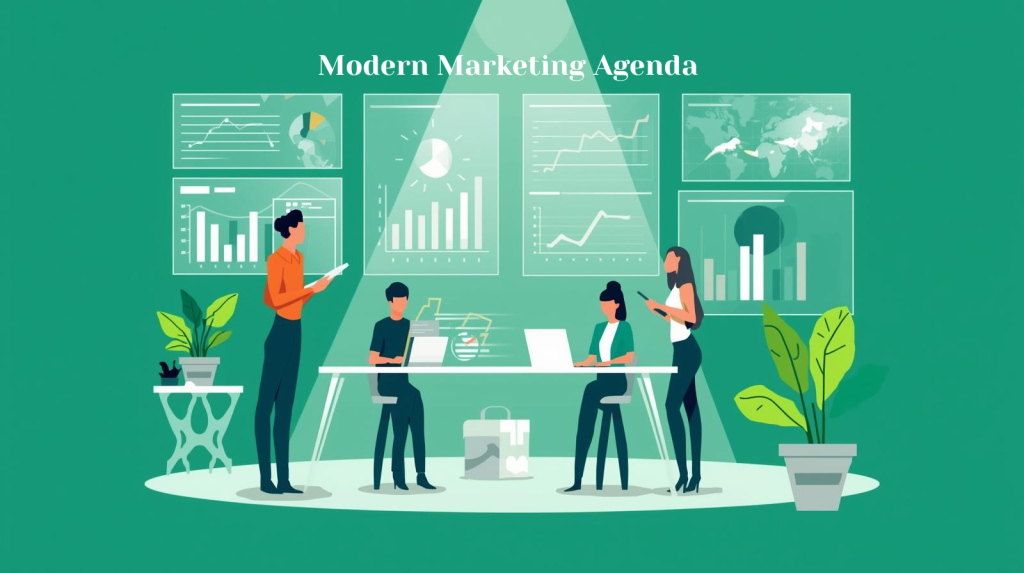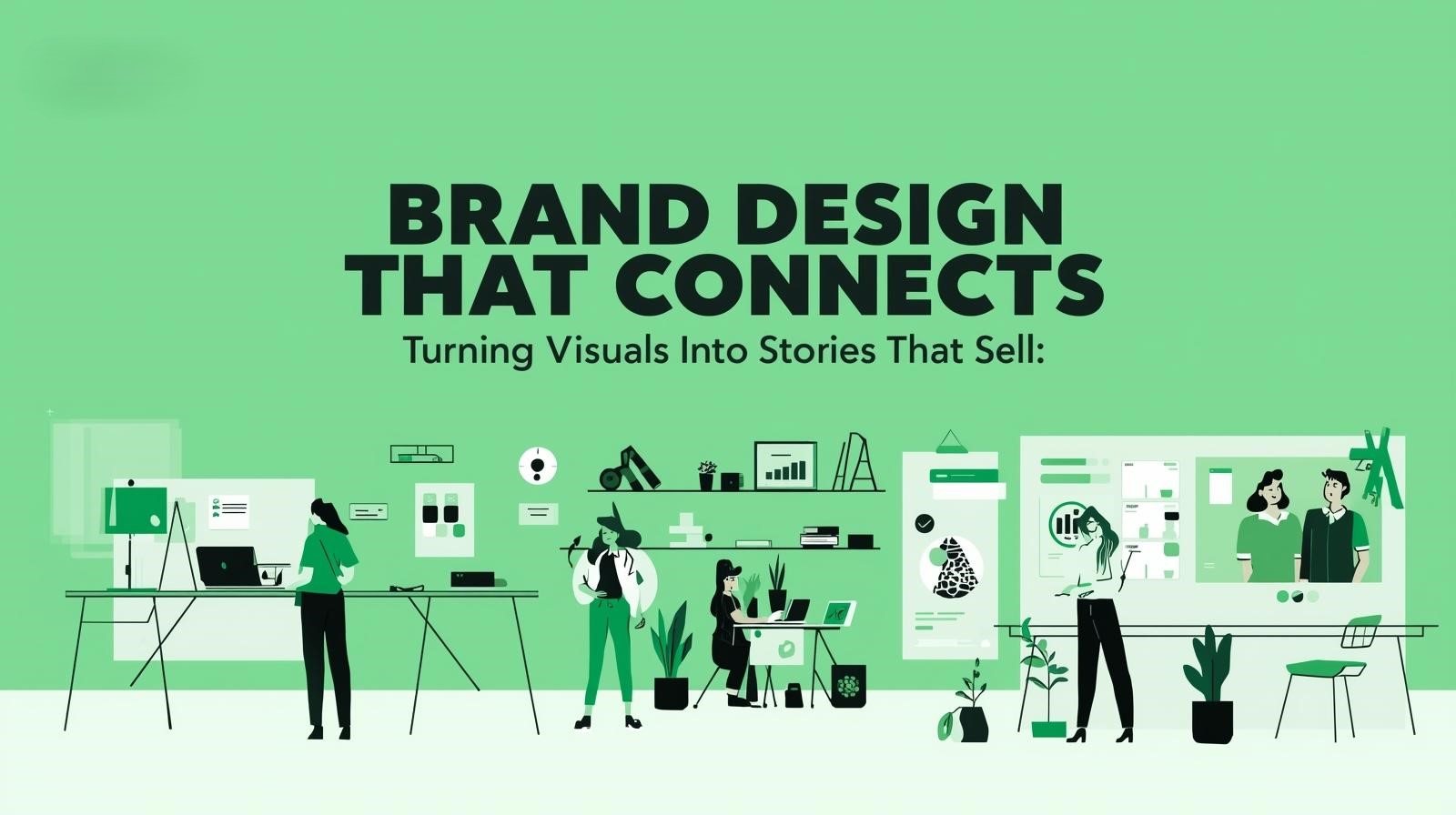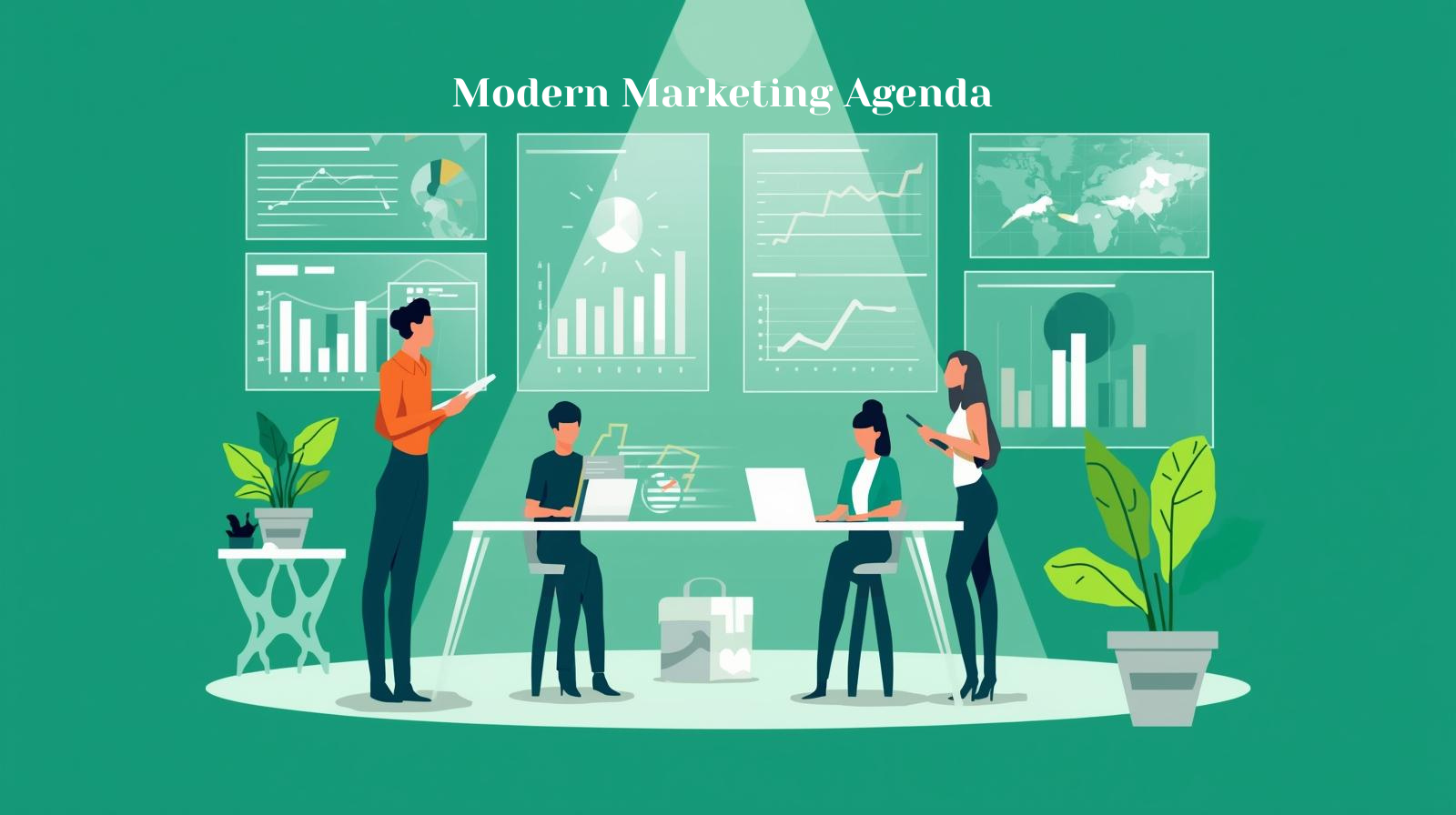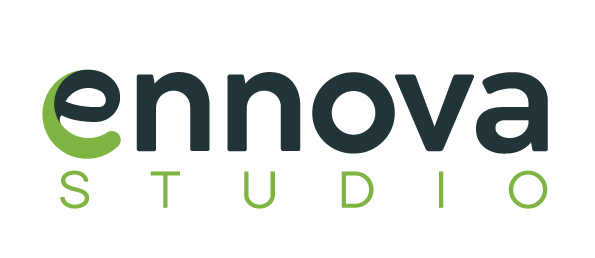In 2025, a strong Marketing Agenda is no longer optional—it’s essential for startups, app builders, small businesses, and any e-commerce brand hoping to turn content into measurable growth. With rising ad costs, stricter privacy laws, and content saturation everywhere, only those who build conversion-focused content strategies will truly stand out and scale.
If you’re looking for a trusted partner to bring your app idea to life, read our full post on Why Ennova Studio Is the Mobile App Development Company You Need.
Summary Box
1- Define your Marketing Agenda as a system of content strategies that map to buyer intent & drive conversions.
2- Leverage audience intelligence, human-centric storytelling, and conversion copy to cut through content saturation.
3- Use interactive visuals, UGC, short-form video & clear CTAs to boost CTR & engagement.
4- Continuously optimize: audit content, test variations, refresh evergreen pieces, and personalize via data & AI.
Table of Contents
1. Core Components of a Conversion-Focused Marketing Agenda
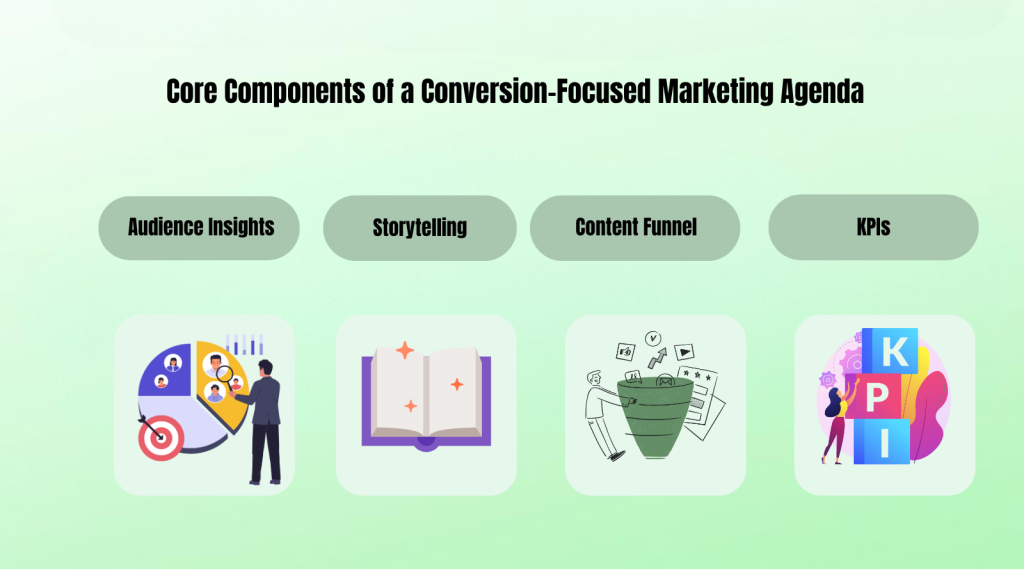
1.1 Audience Intelligence & Intent Mapping
When you lean solely on personas you risk missing the why behind user behavior. Instead, dig into user intent—which typically falls into three types:
- Informational (they want knowledge)
- Commercial / consideration (they’re comparing options)
- Transactional / decision (they’re ready to act)
How to uncover that intent:
- Talk to your front line — sales, support, onboarding teams often hear real objections and questions your content should answer
- Surveys & polls — ask users directly what problems they’re solving
- Social listening — monitor forums, comments, Q&A sites to see what language people use
- Keyword intent mapping — take long-tail keywords and slot them into stages: e.g. “how to build e-commerce site” (informational), “best Shopify vs WooCommerce” (commercial), “buy Shopify plan” (transactional)
When you map your content to actual intent, you stop chasing page views and start writing for action.
1.2 Storytelling vs. Saturation
In 2025, the danger is you get drowned in a sea of equally “optimized” content. Generic, overly polished content is becoming white noise.
- Authenticity wins. Audiences are savvier. They see clichés, stock photos, and corporate-speak—and tune out.
- Stats support this: 87% of brands use user-generated content (UGC) because it’s perceived as more authentic and engaging (emplifi).
- User trust leans toward UGC — reviews, photos from real users, candid stories—those resonate more deeply (entrepreneur).
Use human story structures. For example:
Problem → Journey (struggles, turning point) → Outcome (results, transformation)
You can apply this to case studies, customer stories, or even brand origin tales.
1.3 Mapping Content to the Buyer’s Journey
Your marketing agenda should ensure there’s content for every step in the journey.
- TOFU (Top of Funnel): Raise awareness. Use education, how-to articles, infographics, explainer videos.
- MOFU (Middle): Build trust. Offer webinars, e-books, comparison guides, checklists. These are often gated or require an email.
- BOFU (Bottom): Drive decision & conversion. Use case studies, demos, testimonials, free trials, special offers.
Why this matters: studies show that nearly 66% of marketers report that their average landing page conversion rate is below 10% (Hubspot).
If your content doesn’t map to all three stages, you leave “leaks” in the funnel.
2. High-CTR Formats & Tactics That Deliver
2.1 Visuals, Interactive Content & Short Videos
Visual & interactive formats are no longer optional—they’re a must.
- Short-form video (Reels, TikTok, Shorts) continues to dominate. In 2025, it’s expected to be the format people lean into (sproutsocial).
- Over 56% of business videos are now under 2 minutes to match shorter attention spans (firework).
- Interactive formats like quizzes, calculators, polls don’t just entertain—they engage and give you actionable data
- Infographics help turn dense data into digestible visuals. Visual content is often up to 43% more persuasive than text alone.
2.2 Conversion Copy & CTAs with Psychology
Words matter. Here’s how to tilt copy toward conversion:
- Headlines: lead with benefit + urgency + clarity (e.g. “Boost Your Sales in 30 Days with This Content Agenda”)
- CTAs: make them action-forward (“Download Guide Now”, “Start Free Trial”) and visually distinct
- Psychological triggers you can use:
- Social proof (testimonials, numbers)
- Authority (expert quotes, case studies)
- Scarcity (“limited spots”, “expires soon”)
- Reciprocity (give something small first, then ask)
Remember: content optimized for conversion is more than SEO + info—it’s persuasion.
2.3 UGC & Social Proof in Your Agenda
User-generated content (UGC) can become a trust engine in your marketing:
- Encourage customers to submit photos, videos, reviews
- Embed those stories/testimonials across your website, landing pages, email
- Amplify UGC via social media and even paid channels to bring authenticity into more places
Some compelling numbers:
- UGC increases campaign engagement by ~28% vs purely branded content (everyonesocial).
- 93% of marketers say UGC performs significantly better than traditional branded content (embedsocial).
- 82% of consumers say they’re more likely to purchase from a brand using UGC (entribe).
So when your marketing agenda includes UGC as a strategy—not an afterthought—you build stronger trust and higher conversion potential.
3. Optimize & Personalize Your Agenda at Scale
3.1 Content Audits & Refresh Strategy
It’s not enough to publish new content constantly. You also need to audit and refresh what you already have:
- Audit: look for content gaps in key journey stages, check top-performing vs low-performing pages
- Refresh evergreen content: update stats, add better visuals, carve in new CTAs, reoptimize keywords
- Given the pace of change today, refreshing old content often yields better ROI than creating brand-new from scratch.
3.2 AI-powered Personalization & Dynamic Content
Modern businesses are leaning into personalization—not one-size-fits-all content but experiences tailored to the user.
- Use first-party data (behavior, demographics, past interactions) to segment and personalize
- Leverage dynamic content systems: show different offers, headlines, or visuals based on the user’s stage or profile
- AI tools can help automate personalization, but the human insight must still guide the rules and guardrails
3.3 A/B Testing & Data-Driven Improvement
You won’t hit perfect on first try—so test everything:
- Test headlines, images, CTAs, layouts, even value propositions
- Use sound statistical protocols to ensure your results are valid
- Use analytics to interpret results and double down on what works
- As complexity grows, consider multivariate testing (test multiple elements at once) to find optimal combos.
By embedding a culture of testing and optimization into your marketing agenda, you turn guesswork into steady improvement.
Conclusion: Build Your Sustainable Content-to-Conversion Engine
A modern marketing agenda isn’t about chasing every new trend — it’s about building a repeatable system that works. Know your audience, tell real stories, use the right content formats, track what matters, and keep improving through data and personalization.
Start small and stay consistent. Test, learn, and adjust along the way — that’s how real growth happens.
FAQs
1. What’s the difference between a marketing plan, a marketing strategy, and a marketing agenda?
Marketing Strategy:
This is your big-picture game plan — it explains why you’re marketing in the first place. It focuses on long-term goals like building brand awareness, reaching new audiences, or expanding into new markets.
Marketing Plan:
Think of this as the detailed roadmap. It breaks your strategy into specific goals (like “increase sales by 10% this quarter”), defines your target audience, reviews competitors, and sets your budget.
Marketing Agenda:
This is the action checklist — the who, what, and when of marketing. It includes your weekly or monthly tasks, campaigns, and deadlines that put your marketing plan into motion.
2. How do I make sure my marketing agenda is aligned with our business goals?
Alignment is key to proving your marketing ROI. Here’s how to make it happen:
Start with the “Why”: Every task — whether it’s a blog post or a social media ad — should connect directly to a clear goal in your marketing plan.
Set SMART Goals: Make your objectives Specific, Measurable, Achievable, Relevant, and Time-bound. For example, instead of saying “increase sales,” say “generate 500 new qualified leads through content marketing by Q4.”
Keep Communication Open: Get marketing, sales, and customer support teams talking regularly. A strong marketing agenda aligns everyone around the customer journey and keeps your company working toward the same goals.
3. What should a marketing agenda include to be effective?
A great marketing agenda is more than just a to-do list. It should include:
Top Priorities: Start with your most important campaigns and projects.
Key Deliverables: List the exact content or creative materials needed for each campaign.
Timeline & Deadlines: Set clear start and end dates for every task and milestone.
Channel Plan: Decide where each activity will run — email, social media, paid ads, etc.
Task Owners: Assign who’s responsible for each item to keep everyone accountable.
KPIs (Metrics for Success): Define how you’ll measure results, like conversion rates, clicks, or engagement.
4. How often should we revisit and revise our marketing agenda?
The digital marketing world changes fast — a static agenda won’t survive.
Review Quarterly: Take time every quarter to review your performance against SMART goals, check out what competitors are doing, and make sure your goals still make sense.
Track and Adjust Often: The best marketing teams monitor their metrics weekly (or even daily) and make small, data-driven tweaks to improve results. Tools like analytics dashboards make it easy to see what’s working and what’s not.
Stay Flexible: Be ready to pivot when the market shifts, new competitors emerge, or your audience’s needs change. Agility is one of the biggest strengths of any modern marketing team.

